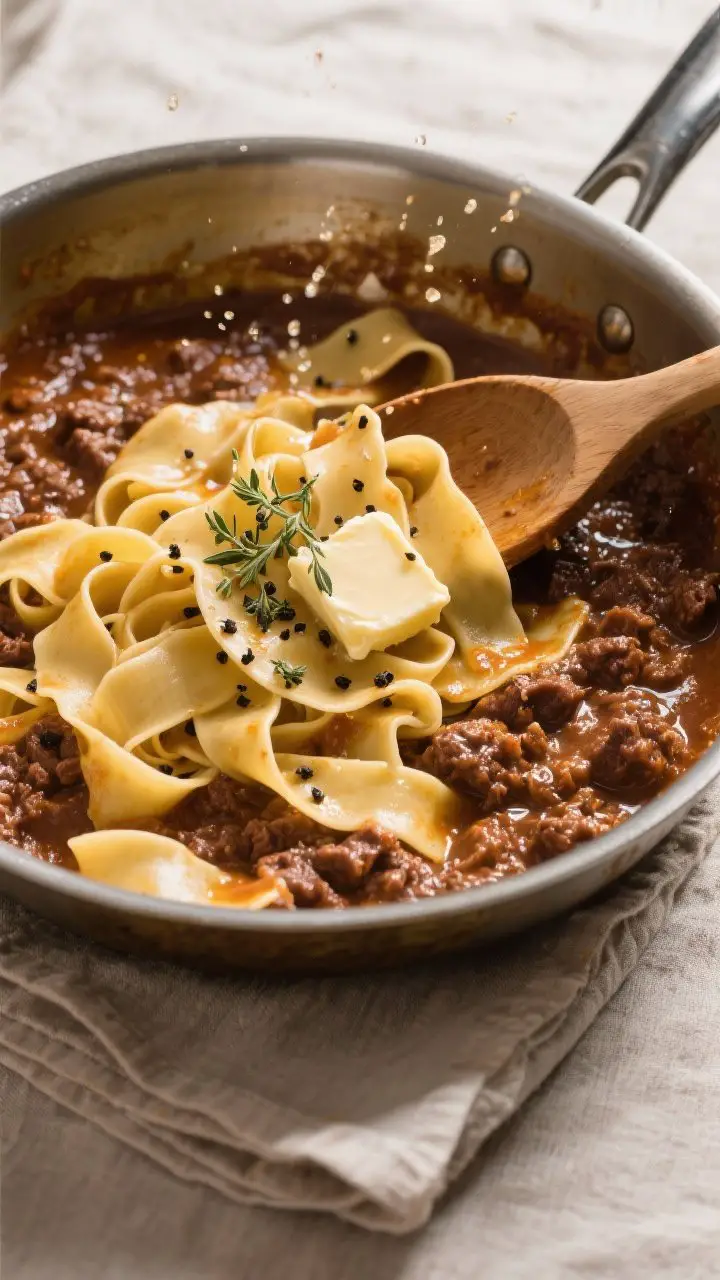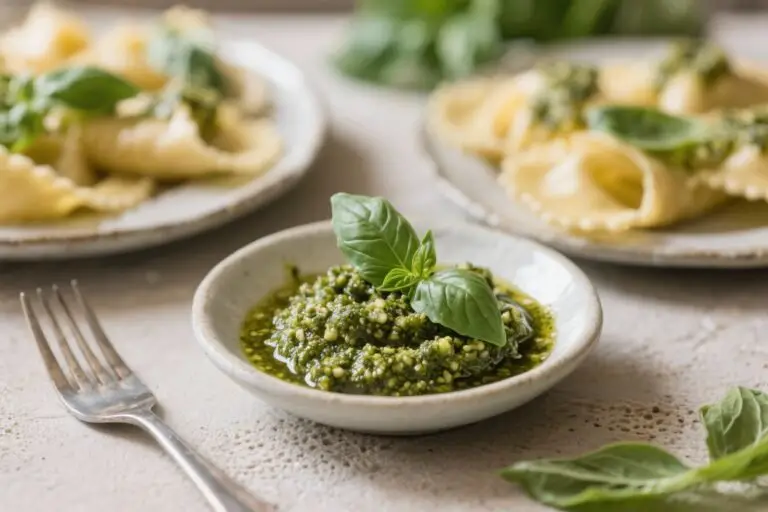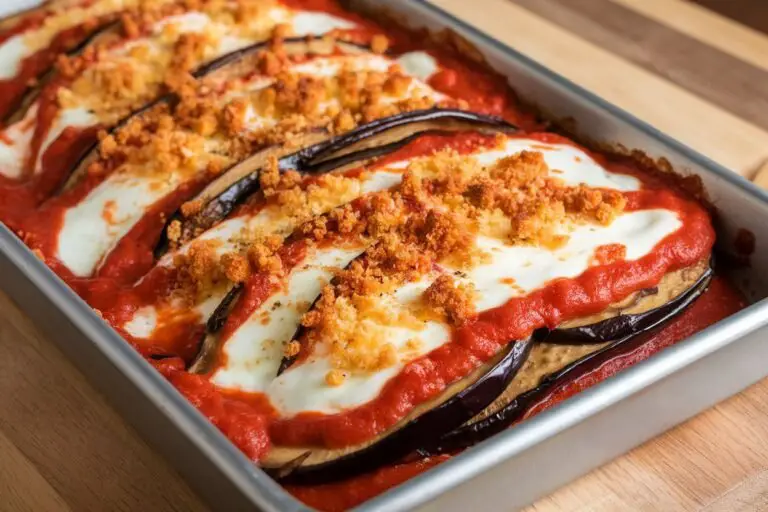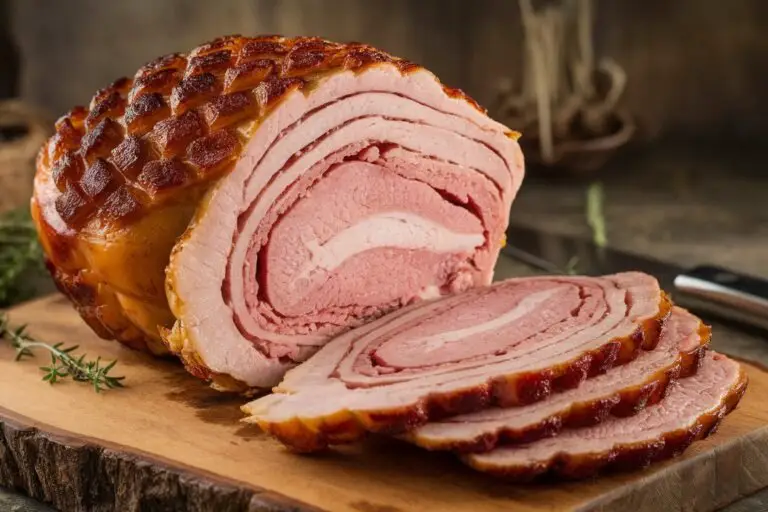How to Make Italian Beef Ragu That Tastes Like You Stole Nonna’s Secret (But Better)
Picture this: a pot bubbling away, your kitchen smelling like Tuscany with a side of “whoa.” Italian beef ragu isn’t just dinner—it’s a power play. It turns cheap cuts into luxury with time, patience, and a little swagger. If you’ve ever wanted to make a sauce that silences the table, this is your moment.
Let’s build a ragu that clings to pasta like it means it—and tastes like you’ve been practicing for years.
Why This Recipe Works

- Low-and-slow magic: Collagen-rich beef (like chuck) breaks down into silk, creating a sauce that’s rich without being greasy.
- Balanced flavor architecture: The holy trinity—onion, carrot, celery—adds sweetness and depth, while tomato paste and wine bring acidity and umami.
- Layered browning: Searing the beef and caramelizing the soffritto build a foundation that store-bought jars can only dream of.
- Starches meet sauce: Finishing with pasta water helps the sauce coat every strand. You’re not making soup—you’re making velvet.
- Forgiving and scalable: This ragu loves time and reheats like a champ. Batch it on Sunday, eat like royalty all week.
Ingredients Breakdown
- 2.5 lb (1.1 kg) beef chuck, cut into 1.5-inch chunks (rich in collagen; melts into tenderness)
- 2 tbsp olive oil (for searing)
- 1 large onion, finely diced
- 2 carrots, finely diced
- 2 celery stalks, finely diced
- 4 cloves garlic, minced
- 2 tbsp tomato paste (concentrated umami and color)
- 1 cup dry red wine (Sangiovese, Montepulciano, or any dry red you’d drink)
- 1 can (28 oz/800 g) crushed tomatoes
- 1 cup beef stock (low sodium)
- 1 bay leaf
- 1 tsp dried oregano or Italian seasoning
- 1–2 sprigs fresh rosemary or thyme
- 1–2 tsp sugar (optional; to balance acidity)
- Salt and freshly ground black pepper, to taste
- 2 tbsp butter (optional; for finishing silkiness)
- Freshly grated Parmigiano-Reggiano, for serving
- Pappardelle, tagliatelle, or polenta, to serve
Step-by-Step Instructions

- Prep the beef: Pat chunks dry and season generously with salt and pepper.
Dry meat browns, wet meat steams—choose wisely.
- Sear like you mean it: Heat olive oil in a heavy Dutch oven over medium-high. Sear beef in batches until deeply browned on all sides, 8–10 minutes total per batch. Transfer to a plate.
- Build the soffritto: Reduce heat to medium.
Add onion, carrot, and celery with a pinch of salt. Cook 8–10 minutes, stirring, until soft and lightly caramelized. Add garlic; cook 1 minute until fragrant, not burnt.
- Tomato paste time: Stir in tomato paste and cook 2–3 minutes until brick red and slightly sticky.
This is where the umami gets jacked up.
- Deglaze with wine: Pour in red wine, scraping up fond. Simmer 2–3 minutes to cook off alcohol and concentrate flavor.
- Tomatoes and stock: Add crushed tomatoes, beef stock, bay leaf, oregano, and rosemary/thyme. Return beef and any juices.
Bring to a gentle simmer.
- Low and slow simmer: Cover partially and cook on low for 2.5–3 hours, stirring occasionally. You want gentle blips, not a rolling boil. Add a splash of water if it thickens too fast.
- Shred and reduce: Remove herbs.
Shred beef with two forks directly in the pot. Simmer uncovered 15–20 minutes to thicken into a spoon-coating sauce. Adjust salt, pepper, and add sugar if needed.
- Finish like a pro: Stir in butter for gloss and body.
Taste again. If it doesn’t make you grin, season smarter, not louder.
- Marry with pasta: Cook pappardelle until just under al dente. Reserve 1/2 cup pasta water.
Toss pasta with ragu and a splash of pasta water over low heat until glossy and clinging. Shower with Parmigiano.
How to Store
- Fridge: Cool completely. Store in airtight containers up to 4 days.
It actually tastes better on day two. Science? No—magic.
- Freezer: Portion into freezer-safe containers or bags for up to 3 months.
Flatten bags for faster thawing.
- Reheat: Warm gently on the stove with a splash of water or stock. Avoid blasting it in the microwave—this sauce deserves respect.

Nutritional Perks
- Protein powerhouse: Beef chuck delivers ample protein to keep you full and energized.
- Collagen conversion: Slow cooking breaks down connective tissue into gelatin for a luxurious texture without excessive fat.
- Veggie boost: Onion, carrot, and celery add fiber, vitamins, and natural sweetness—aka flavor with benefits.
- Customizable fat: Skim surface fat after chilling if you want a leaner profile. FYI, flavor still stays strong.
Avoid These Mistakes
- Crowding the pan during sear: If the beef steams, you lose the Maillard magic.
Work in batches.
- Boiling the sauce: High heat makes meat tough and sauce thin. Low and slow wins.
- Skipping the tomato paste toast: Raw paste tastes flat. Cook it until it darkens.
- Under-salting: This is a big pot of flavor—season in layers and taste at the end.
- Forgetting to finish: Butter, Parmigiano, and pasta water take it from “good” to “wow.” Don’t phone in the final 5%.
Mix It Up
- Mushroom upgrade: Add 8 oz finely chopped cremini with the soffritto for extra umami.
- Pancetta start: Render 3 oz diced pancetta before the soffritto for a smoky, savory base.
- White wine variant: Use dry white wine and finish with lemon zest for a brighter profile.
- Polenta pairing: Serve over creamy polenta with a drizzle of olive oil when you want serious comfort.
- Herb swap: Try sage and thyme in fall; basil and parsley in spring for freshness.
- Spice nudge: A pinch of red pepper flakes wakes things up—don’t turn it into arrabbiata, though.
FAQ
Can I make this in a slow cooker?
Yes.
📖 Get Access to 50+ Printable Smoothie Recipes Instantly! 🖨️
Boost your health with delicious smoothies! These easy-to-follow printable recipe eBooks are perfect for detoxing, fitness goals, and tasty plant-based living. Available for instant download on Etsy! 🌿✨
Sear the beef and cook the soffritto on the stove first, then transfer everything to a slow cooker. Cook on low for 8–9 hours until shreddable. Reduce the sauce uncovered at the end if it’s too loose.
What’s the best beef cut for ragu?
Beef chuck is ideal—well-marbled with connective tissue that breaks down beautifully.
Brisket or short rib also work, but chuck gives the best value-to-flavor ratio, IMO.
Do I have to use wine?
No, but it adds depth and acidity. Substitute with extra beef stock plus 1 tablespoon balsamic vinegar for a similar effect.
Can I use fresh tomatoes?
You can, but canned crushed tomatoes provide consistent sweetness and texture year-round. If using fresh, peel, core, and crush about 2.5–3 pounds of ripe plum tomatoes and cook longer to reduce.
How thick should the ragu be?
It should coat the back of a spoon and cling to pasta.
If it’s runny, simmer uncovered to reduce. If it’s too thick, splash in stock or reserved pasta water.
Is this the same as Bolognese?
Not exactly. Traditional Bolognese often includes milk and finely ground meat.
This ragu is chunkier with shredded beef and a richer, braised profile.
What pasta shape works best?
Pappardelle and tagliatelle are classics. Rigatoni or paccheri also hold up to the hearty sauce. Thin spaghetti?
It’ll do in a pinch but won’t flex as hard.
Final Thoughts
Italian beef ragu wins because it respects time and rewards patience. You brown, you simmer, you shred, and suddenly you’re the hero of dinner. Make a big batch, stash some for later, and let future-you send a thank-you note.
This is comfort with edge—sophisticated, rugged, and ridiculously satisfying. Now go make the pot that makes people ask for seconds before they’ve finished firsts.







